Logical reasoning questions are very frequent in several competitions, entrance exams and also in the Enem test. Therefore, don't miss the opportunity to practice this type of question with the solved and commented exercises.
question 1
Discover the logic and complete the next element:
a) 1, 3, 5, 7, ___
b) 2, 4, 8, 16, 32, 64, ____
c) 0, 1, 4, 9, 16, 25, 36, ____
d) 4, 16, 36, 64, ____
e) 1, 1, 2, 3, 5, 8, ____
f) 2.10, 12, 16, 17, 18, 19, ____
Answers:
The) 9. Sequence of odd numbers or + 2 (1+2=3; 3+2=5; 5+2=7; 7+2=9)
B) 128. Sequence based on multiplication by 2 (2x2=4; 4x2=8; 8x2=16... 64x2=128)
ç) 49. Sequence based on adding another sequence of odd numbers (+1, +3, +5, +7, +9, +11, +13)
d) 100. Square sequence of even numbers (22, 42, 62, 82, 102).
and) 13. Sequence based on the sum of the two previous elements: 1 (first element), 1 (second element), 1+1=2, 1+2=3, 2+3=5, 3+5=8, 5+8=13.
f) 200. Numeric sequence based on a non-numeric element, the initial letter of the number written in full: dhi, deh, deleven, dsixteen, dseventeen, deighteen, dnineteen, dhundred.
It is important to be aware of the possibilities of paradigm shifts, in this case, the numbers written out in full, which do not operate in a quantitative logic like the others.
question 2
(Enem) Playing cards is an activity that stimulates reasoning. A traditional game is Solitaire, which uses 52 cards. Initially, seven columns are formed with the cards. The first column has one card, the second has two cards, the third has three cards, the fourth has four cards, and so on successively to the seventh column, which has seven cards, and what makes up the pile, which are the unused cards in the columns.
The number of cards that make up the pile is
a) 21.
b) 24.
c) 26.
d) 28.
e) 31.
correct alternative: b) 24
To find out the number of cards that are left in the pile, we must decrease from the total number of cards the number of cards that were used in the 7 columns.
The total number of cards used in the columns is found by adding the cards of each one of them, thus, we have:
1 + 2 + 3 + 4 + 5 + 6 + 7 = 28
Doing the subtraction, we find:
52 - 28 = 24
question 3
(UERJ) In a coding system, AB represents the digits of a person's day of birth and CD the digits of their month of birth. In this system, the date of July 30th, for example, would correspond to:
Admit a person whose birth date meets the following condition:
This person's month of birth is:
a) august
b) september
c) october
d) november
correct alternative: b) september
The sums of the figures relating to the days of the month range from 1 to 11. The sum of the figures for the month ranges from 1 to 9.
Therefore, we observe that 11 + 9 = 20, which are the maximum values of the sum. Therefore, this combination is the only one possible to resolve the issue. Thus, the sum of the month equal to 9 is the month of September.
question 4
(FGV/TCE-SE) Two turtles were together and began to walk in a straight line towards a distant lake. The first turtle traveled 30 meters a day and took 16 days to reach the lake. The second turtle was only able to travel 20 meters a day and therefore reached the lake a few days after the first. When the first turtle arrived at the lake, the number of days she had to wait for the second turtle to arrive was:
a) 8
b) 9
c) 10
d) 12
e) 15
correct alternative: a) 8
As the first turtle walked 30 meters a day, in 16 days it will have covered:
16. 30 = 480 meters
To find out how long the second turtle will take to travel the 480 meters, just divide by the 20 meters traveled per day, so we have:
480: 20 = 24 days
Thus, the waiting time for the first turtle will be:
24 - 16 = 8
question 5
(FGV/TRT-SC) Some consider that the city of Florianópolis was founded on March 23, 1726, which fell on a Saturday. After 90 days, on June 21st, the date marked the beginning of winter, when the night is the longest of the year. That day fell into one:
Monday
b) tuesday
c) wednesday
d) thursday
it's Friday
correct alternative: it's Friday
As we have a 7-day interval between Saturdays and another, let's divide the 90 by 7 to see how many weeks we will have in this interval. The result of this division is 12 weeks and 6 days are left.
Counting six days from Saturday, we have Friday.
question 6
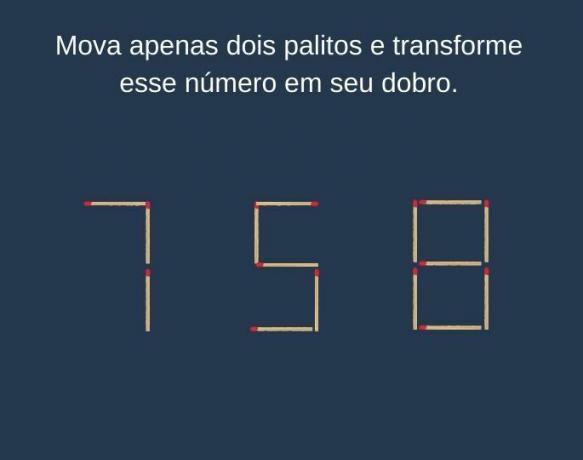
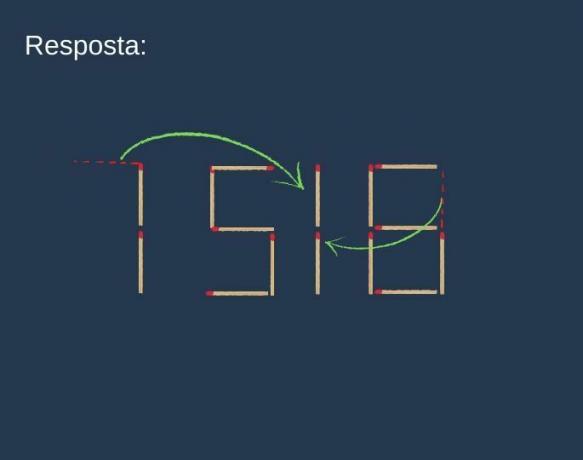
question 7
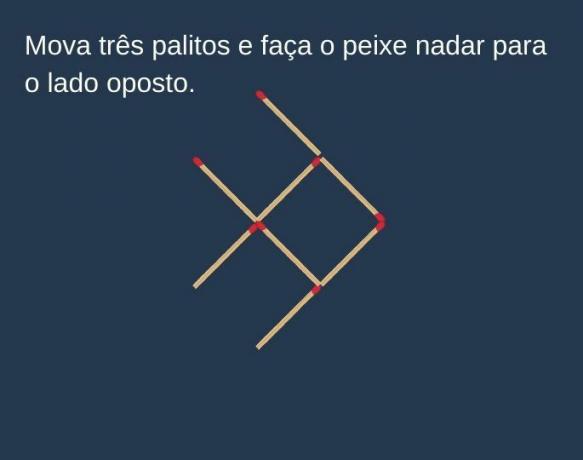
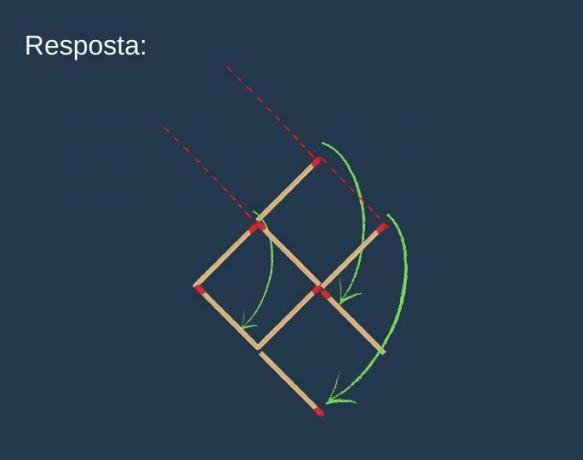
question 8
(Enem) The following figures show an excerpt of a puzzle being assembled. Note that the pieces are square and there are 8 pieces on the board of figure A and 8 pieces on the board of figure B. The pieces are removed from the board of figure B and placed on the board of figure A in the correct position, that is, in order to complete the drawings.

It is possible to correctly fill the space indicated by the arrow on the board of figure A by placing the piece
a) 1 after turning it 90° clockwise.
b) 1 after turning it 180° counterclockwise.
c) 2 after turning it 90° counterclockwise.
d) 2 after turning it 180° clockwise.
e) 2 after turning it 270° counterclockwise.
correct alternative: c) 2 after turning it 90° counterclockwise.
Observing figure A, we notice that the piece that should be placed in the indicated position must have the lightest triangle, to complete the lightest square.
Based on this fact, we chose piece 2 of figure B, as piece 1 does not have this clearer triangle. However, to fit into position, the piece must be rotated 90° counterclockwise.
question 9
(FGV/CODEBA) The figure shows the flatness of the faces of a cube.
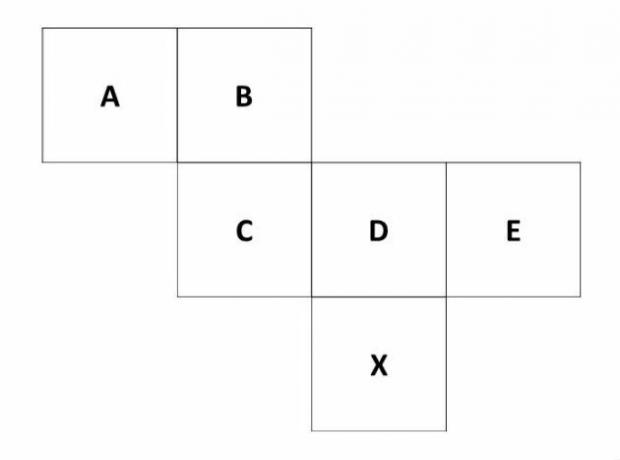
In this cube, the face opposite face X is
a) A
b) B
c) C
d) D
and is
correct alternative: b) B
To resolve the issue, it is important to imagine assembling the cube. For this, we can visualize, for example, the face C facing in front of us. Face B will face up and face X will face down.
Therefore, B is the opposite face of X.
question 10
(Enem) João proposed a challenge to Bruno, his classmate: he would describe a displacement by pyramid to follow and Bruno should draw the projection of this displacement on the base plane of the pyramid.
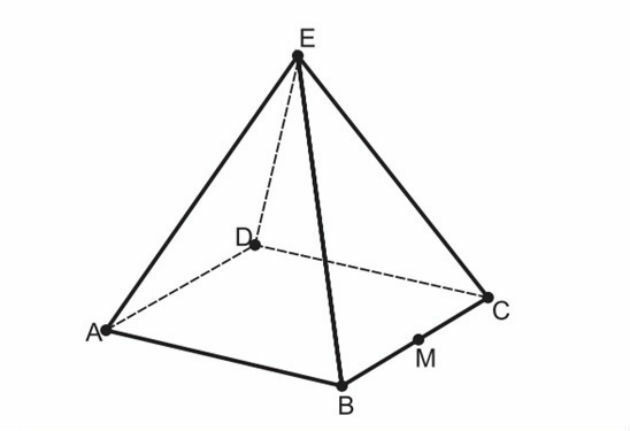
The displacement described by João was: move through the pyramid, always in a straight line, from point A to point E, then from point E to point M, and then from M to C. The drawing that Bruno must do is
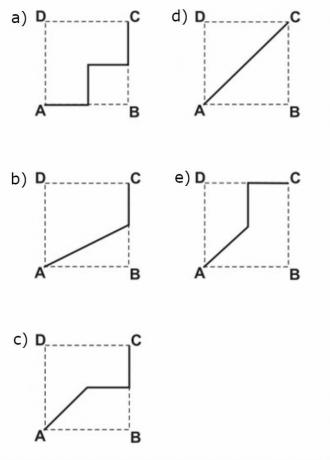
correct alternative: Ç
To resolve the issue, we must consider that the pyramid has a square base and is regular. In this way, the projection of point E at the base of the pyramid will be exactly at the center point of the base square.
Once this is done, just connect the indicated points, as shown in the drawing below:
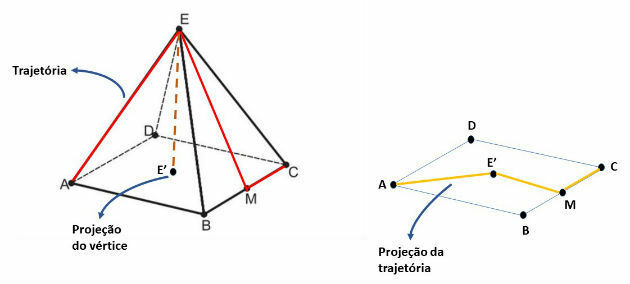
question 11
Four suspects of committing a crime make the following statements:
- John: Carlos is the criminal
- Peter: I'm not a criminal
- Carlos: Paulo is the criminal
- Paulo: Carlos is lying
Knowing that only one of the suspects lies, determine who the criminal is.
a) John
b) Peter
c) Carlos
d) Paul
correct alternative: c) Carlos.
Only one suspect lies and the others tell the truth. Thus, there is a contradiction between John's and Carlos' declarations.
1st option: If João tells the truth, Pedro's statement could be true, Carlos' statement would be false (because it is contradictory) and Paulo would be telling the truth.
2nd option: If John's statement is false and Carlos' statement is true, Peter's statement may be true, but Paul's statement would have to be false.
Therefore, there would be two false statements (John and Paul), invalidating the issue (only one falsehood).
Thus, the only valid option is for João to tell the truth and Carlos to be the criminal.
question 12
(Vunesp/TJ-SP) Knowing that the statement “All students from So-and-so passed the contest” is true, then it is necessarily true:
a) So-and-so did not pass the contest.
b) If Roberto is not a student of So-and-so, then he did not pass the contest.
c) So-and-so passed the contest.
d) If Carlos did not pass the contest, then he is not a student of So-and-so.
e) If Elvis passed the contest, then he is a student of So-and-so.
correct alternative: d) If Carlos did not pass the contest, then he is not a student of So-and-so.
Let's analyze each statement:
The letters a and c indicate information about So-and-so. However, the information we have is about So-and-so's students, so we can't say anything about So-and-so.
Letter b talks about Roberto. As he is not a student of So-and-so, we cannot say whether it is true either.
The letter d says that Carlos was not approved. Since all students of So-and-so have passed, therefore, he cannot be a student of So-and-so. So this alternative is necessarily true.
Finally, the letter d is not correct either, as we were not informed that only the students of So-and-so who passed.
question 13
(FGV/ TJ-AM) Dona Maria has four children: Francisco, Paulo, Raimundo and Sebastião. In this regard, it is known that:
I. Sebastião is older than Raimundo.
II. Francisco is younger than Paulo.
III. Paulo is older than Raimundo.
Thus, it is necessarily true that:
a) Paul is the oldest.
b) Raimundo is the youngest.
c) Francisco is the youngest.
d) Raimundo is not the youngest.
e) Sebastião is not the youngest.
correct alternative: e) Sebastião is not the youngest.
Considering the information, we have:
Sebastião > Raimundo => Sebastião is not the youngest and Raimundo is not the oldest
Francisco Paulo is not the youngest and Francisco is not the oldest
Paulo > Raimundo => Paulo is not the youngest and Raimundo is not the oldest
We know that Paul is not the youngest, but we cannot say that he is the oldest. Thus, alternative "a" is not necessarily true.
The same can be said of the letters b and c, as we know that Raimundo and Francisco are not the oldest, but we cannot say that they are the youngest.
Therefore, the only option that is necessarily true is that Sebastião is not the youngest.
question 14
(FGV/Pref. from Salvador-BA) Alice, Bruno, Carlos and Denise are the first four people in a row, not necessarily in that order. João looks at the four and says:
- Bruno and Carlos are in consecutive positions in the queue;
- Alice is between Bruno and Carlos in the queue.
However, both of John's statements are false. Bruno is known to be third in line. The second in line is
a) Alice.
b) Bruno.
c) Carlos.
d) Denise.
e) John.
correct alternative: d) Denise
As Bruno is third in line and is not in a consecutive position with Carlos, so Carlos can only be first in line. Alice then, can only be the last, as she is not between Bruno and Carlos.
With that, second in line can only be Denise.
question 15
(FGV/TCE-SE) Consider the statement: "If today is Saturday, tomorrow I will not work." The denial of this statement is:
a) Today is Saturday and tomorrow I will work.
b) Today is not Saturday and tomorrow I will work.
c) Today is not Saturday or tomorrow I will work.
d) If today is not Saturday, tomorrow I will work.
e) If today is not Saturday, tomorrow I will not work.
correct alternative: a) Today is Saturday and tomorrow I will work.
The question presents a conditional proposition of the type "If..., then", although the connective "then" does not appear explicit in the sentence.
In this type of proposition, we can only ensure that when the sentence enters the if it's the then is true, the sentence after the then it will also be true.
This can be summarized in the truth table of the conditional propositions indicated below, where we consider p: "today is Saturday" and q: "tomorrow I will not work".
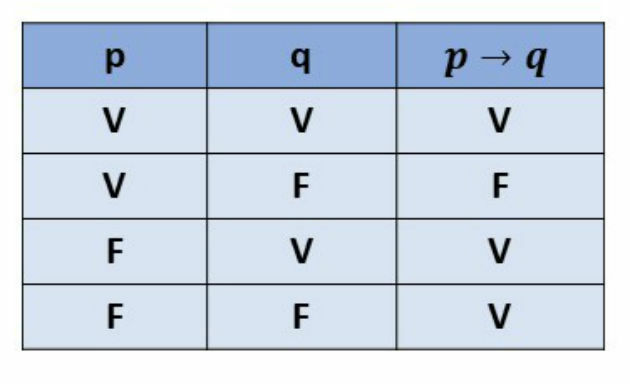
In the question, we want the negation of the statement, that is, the false proposition. From the chart, we observe that the false proposition occurs when p is true and q is false.
In this way, let's write the denial of q that is: tomorrow I will work.
question 16
(Vunesp/TJ-SP) In a building with apartments only on floors 1 to 4, 4 girls live on different floors: Joana, Yara, Kelly and Bete, not necessarily in that order. Each of them has a different pet: cat, dog, bird and turtle, not necessarily in that order. Bete is always complaining about the noise made by the dog, on the floor immediately above hers. Joana, who does not live on the 4th, lives one floor above Kelly, who has the bird and does not live on the 2nd floor. Whoever lives on the 3rd floor has a turtle. Therefore, it is correct to say that
a) Kelly does not live on the 1st floor.
b) Beth has a cat.
c) Joana lives on the 3rd floor and has a cat.
d) the cat is the pet of the girl who lives on the 1st floor.
e) Yara lives on the 4th floor and has a dog.
correct alternative:d) Yara lives on the 4th floor and has a dog.
To resolve this type of issue with several "characters" it is interesting to set up a table as shown in the image below:
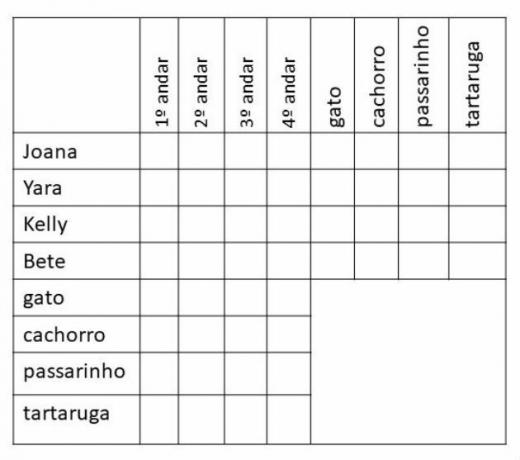
After assembling the table, we will read each of the statements, looking for information and completing with N, when we identify that that situation does not apply to the element of the row with the column.
Likewise, we will complete with S when we can conclude that the information is true for the row/column pair.
Let's start, for example, analyzing the sentence: "Whoever lives on the 3rd floor has a turtle." Using this information we can place S at the intersection in the 3rd floor table with turtle.
As the turtle is on the 3rd floor, so it will not be on the 1st, 2nd and 3rd floor, so we must complete N those corresponding spaces.
So, as no other animals will be on the 3rd floor, so we will also complete with N. Our table will then be:
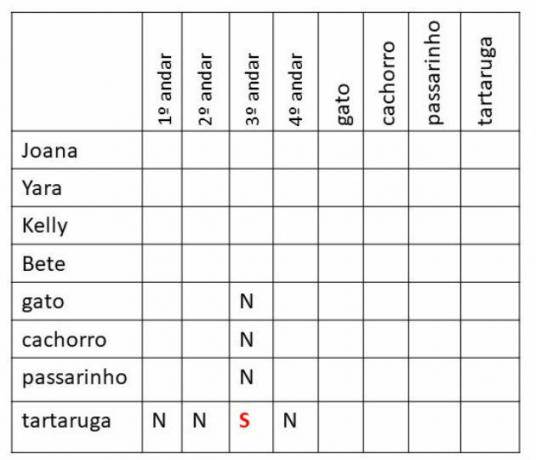
If Beth is always complaining about the dog's noise, this isn't her pet, we can put N at the intersection of Beth's line with the dog column.
We can also identify that Beth does not live on the 4th floor, as the dog is on the floor immediately above hers. She doesn't even live on the 2nd floor, because on the floor immediately above, which would be the 3rd floor, lives the turtle.
Let's put N at the intersection of Joana and 4th floor. Regarding Kelly, we have two pieces of information: she has a bird and does not live on the 2nd floor; therefore, the bird doesn't live on the 2nd floor either.
We can also put that Kelly does not live on the 4th floor, because if Joana lives one floor above Kelly, she cannot live on the 4th floor. So the bird doesn't live on the 4th floor either.
Upon completing this information, we see that only the 1st floor is left for the bird, so Kelly also lives on the 1st floor.
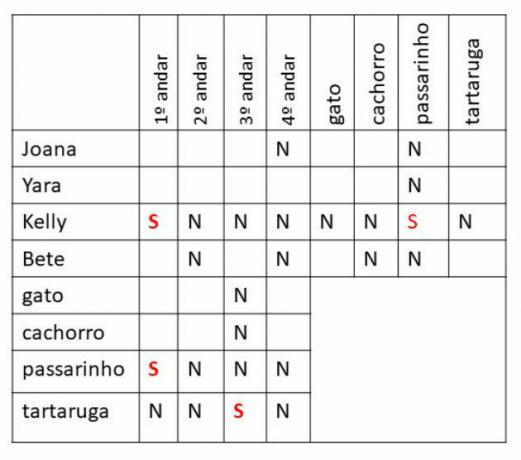
That done, let's look at the table and complete the rows and columns where S appear with N. When there is only one option left, put S. Remembering to also put S in the other corresponding frames.
When completing all the spaces, the table will be as follows:
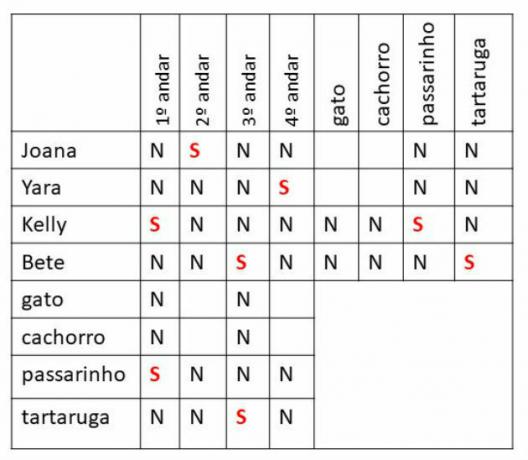
At this point, we see that only information related to Joana and Iara's pets is missing.
To complete the picture, we must remember that the dog is immediately above Beth's floor. As we already found out that she lives on the 3rd floor, so the dog lives on the 4th floor.
Now, just complete the table and identify the correct alternative:

You may also be interested in:
- math challenges
- Probability Exercises
- Numerical sets
- Related Function Exercises
